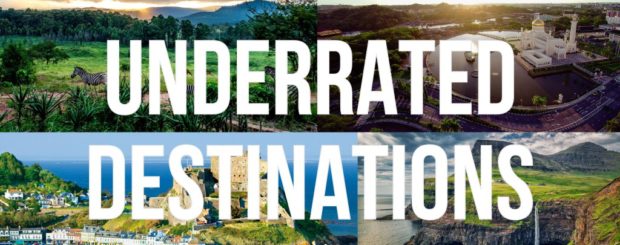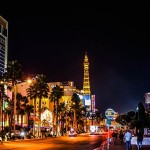5 underrated destinations that should be on your list
Some landmarks are forever in the limelight.
These are the classic destinations, like the Eiffel Tower and the Egyptian pyramids, and also the widely-renowned relative “newcomers”, from the Roman Colosseum to Taj Mahal to the ruins at Chichén Itzá. They are sites bursting with heritage, and there’s no doubt each is worth an awe-filled visit.
But there are less concrete “wonders of the world” in every country, in all regions of the world, be they species of plants and animals, once-in-a-lifetime experiences or lessons in cultural diversity.
“In other countries that are actually popular, they always have some aspect that’s hidden to the big public — some traditions, culture, social customs — and this is what I like to explore,”
– Angela Corrias, travel blogger and founder of ChasingTheUnexpected.com.
But in travel destinations that aren’t very popular with tourists, she says, travelers will see real life and culture anywhere they go — even in the city center.
Travel search engine KAYAK provided Mashable with a list of 236 worldwide destinations with airports, ranked in order from least- to most-searched by U.S. travelers in 2015. Barring areas with travel alerts/warnings issued by the U.S. government, they curated their list from the 36 least-searched on KAYAK, taking into account diversity of location and what each area offers travelers.
“When you go somewhere that no one else is visiting, you get to have a very authentic experience,” said Matt Stabile, founder and editor-in-chief of TheExpeditioner.com. “You will have a much better opportunity to meet locals, interact with them and learn about their cultures.”
Stabile also mentions the possibility of fewer crowds and lines, as well as lower prices or deals for hotels, restaurants and goods and services.
”You increase the likelihood of those kind of serendipitous moments,” he said. ”Being invited to try local cuisine or meeting somebody who could recommend something to see.”
The Faroe Islands
This archipelago — about halfway between Iceland and Norway — is home to shaggy sheep as well as a burgeoning music scene, complete with a score of summer festivals with both Faroese and foreign artists.
“They are like a concentrate of beautiful landscapes, houses, animals and people all gathered in so intimate and well-preserved a place.”
Combined, the 18 islands that make up the Faroes are about eight times the size of Washington D.C. No matter which of the islands travelers choose to explore, each has something unique to offer. An array of colorful grass-roof cottages, painted fishing boats and an official white flag crossed with red and blue await visitors to the harbor in Tórshavn, the capital and largest town in the archipelago.
Heading northeast to a group of six islands called Norðoyggjar promises views of rolling green fields, steep rocky cliffs and shaggy Faroese sheep. In the south are Sandoy, an island known for its expansive beach and art gallery featuring Faroese artists, and Suðuroy, which offers bird cliffs, far-reaching views and deep fjords. And a trip to the western part of the archipelago yields the island of Mykines, which is home to thousands of puffins, a small red-capped lighthouse and a host of hiking opportunities.
Italian photographer Alessio Mesiano says he fell in love with the Faroes when he first visited on holiday in 2008. Now, he returns every year as part of a collaboration with Visit Faroe Islands.
“There are many archipelagos in the world, but what I find unique about the Faroes is the small dimension,” Mesiano said. “They are like a concentrate of beautiful landscapes, houses, animals and people all gathered in so intimate and well-preserved a place.”
Travelers visiting England, Iceland, Denmark, Norway or Scotland can reach the islands via direct flight by Atlantic Airways, and there’s also a (very long) ferry connecting to Denmark and Iceland.
If travelers arrive via plane, their first stop should be the village of Gásadalur’s waterfall, about a 15-minute drive from the Vágar Airport. Other musts include exploring the village and fjords at Mykines, which Mesiano calls “the essence of the Faroe,” taking a stroll through the streets of Tórshavn and sailing into grottoes to see almost 2,000-foot-tall birdcliffs from below near the town of Vestmanna.
The myriad of summer music events includes the G! Festival held every July in Syðrugöta. Attendees should look forward to stages on the beach with a mountain backdrop, hot tubs on the sand and a selection of artists hailing from the likes of the United Kingdom, Sweden, Norway, Iceland, Denmark and the islands themselves.
Pro tip: Summer is the best (read: only) time to visit to take full advantage of everything the Faroes have to offer.
Swaziland
Swaziland is home to rolling flatlands, lush valleys and a flat-topped mountain range that forms the country’s eastern border with Mozambique, but it’s still underrated when it comes to most international travel.
The country has had its fair share of obstacles over the years — drought, high rates of HIV and a struggling economy — but the many aspects that make it unique have no trouble shining through. A rich culture defines Swaziland, illustrated by traditional festivals with participants that often far outnumber observers.
One example is the Umhlanga, or Reed Dance, an eight-day celebration where up to 40,000 young girls cut reeds and present them to the Queen Mother, who is the female head of state and mother of King Mswati III. The celebration occurs every year in late August or early September, and the girls dress in bright colors and dance and sing before the king in groups.
“I did a road trip, and you had to go through Swaziland to get [to Mozambique from Johannesburg],” said Stabile, who traveled there in September 2009. “Turns out it was a really cool country. It had a different feel, different currency, different language… It was a really fun experience, and it was a cool brag experience to say ‘I’ve been to Swaziland.’”
Other must-dos for travelers include visiting the Mkhaya Game Reserve in southeast Swaziland, where animal enthusiasts can encounter the likes of black and white rhinos, elephants, giraffes and hippos on walking or four-wheeler safaris. White-water rafting down the Bulungapoort section of the Usutu River is a key attraction, and in the Malolotja Nature Reserve in northwest Swaziland, travelers can hike over 100 miles of mountain wilderness trails.
Pro tip: If you are already travelling to South Africa, it’s only another 45-minute flight from Johannesburg to Swaziland.
Guernsey and Jersey
“The first word that comes to my mind is charming,” said Holly Smyth, a California school district administrator who traveled to Guernsey three years ago. “You feel like you’re in another world. It’s beautiful, for one thing, because it’s just very lush and green.”
She describes small streets lined with trees that grow together high above the ground, flower vendors, kind people and beautiful architecture.
Guernsey and Jersey are the two principal districts that make up the Channel Islands off the French coast of Normandy. They’re both British Crown dependencies, meaning they’re not part of the United Kingdom, but the UK is responsible for their international relations and defense.
Both islands have rich histories that will likely fascinate war buffs — a dilemma in 1204 required residents to choose between staying loyal to England or switching to France. After pledging continued loyalty to John, King of England and Duke of Normandy, Jersey was invaded by France many times over the next four centuries. During World War II, the Channel Islands were the only part of Britain occupied by German forces; the day they were freed, May 9, 1945, is celebrated annually as Liberation Day.
Visitors to Jersey won’t want to miss the plethora of historical attractions, like the Jersey War Tunnels and the Jersey Museum and Art Gallery, which explores the islands’ history beginning 250,000 years ago. Hidden artwork, towers and exhibits await visitors to the over 800-year-old Mont Orgueil Castle, and at Durrell Wildlife Park, travellers can appreciate orangutans, reptiles and a family of gorillas.
Must-sees in Guernsey include Moulin Huet, a south coast bay that served as inspiration for 1883 Renoir artwork, and the west coast’s Cobo Bay beach, which offers shallow waters and nearby restaurants, as well as surfing, kayaking and coasteering. The Guernsey North Show and Battle of Flowers, which takes place every August, features an outdoor fair and parade of floats made with flowers.
Pro tip: Visitors have to try the ice cream. Jersey and Guernsey cows aren’t well-known for nothing: “Their ice cream just seems so different and better than ours,” said Smyth.
French Guiana
French Guiana, or Guyane, is a melting pot of cultures, languages and traditions if there ever was one, encircled by the Caribbean and an irrepressible jungle. The region is an overseas part of France, and the population is made up of the French, Amerindians, Chinese, Brazilians and descendants from those who escaped the transatlantic slave trade to form their own communities in French Guiana.
Travelers interested in experiencing the region’s diverse wildlife should head to Trésor Nature Reserve in Kaw, which is about an hour and a half’s drive from capital Cayenne and offers boat tours, hiking trails and Amerindian-style huts for overnight stays. Another option is to try a guided trip down one of French Guiana’s many rivers in a pirogue, or dugout canoe — for substantial rapids, go with the Approuague River. Beach enthusiasts will want to check out Rémire-Montjoly, as well as its nearby Rorotá hiking trail that’s often lined with sloths.
“You are never more than five minutes away from a patch of jungle,” said Chicago native Allison Carroll, who is teaching English in elementary schools through a government program. She advises that people be familiar with the French language and rent a car upon arrival. (Interested travelers should take note that the CDC currently advises pregnant women not to travel to French Guiana at this time due to the Zika virus.)
A day trip to the Sunday market in the village of Cacao, mostly inhabited by Hmong refugees, provides the opportunity to discover pho, bubble tea, clothes and crafts. And history buffs will want to head to the Îles du Salut, or Salvation Islands, for a look back in time at the notorious penal colonies that operated for almost one hundred years on the islands, ending in the mid-twentieth century.
Pro tip: Neighboring Suriname is definitely worth a visit via a pirague trip across the Maroni River.
Brunei Darussalam
Imagine an immense white palatial structure featuring a golden dome surrounded by matching minarets, situated in an artificial lagoon next to an ornate ceremonial boat.
That grandiose mental image is a real place — the Sultan Omar Ali Saifuddin Mosque in Brunei’s capital city. The striking structure is meant to honor Allah, and visitors are welcome to enter if properly attired.
Darussalam means “abode of peace” in Arabic, and that’s what this Southeast Asian nation exemplifies to many. Its over 100 miles of coastline are peppered with mangrove swamps, and dense, diverse forest covers nearly three-fourths of the land area.
Because the nation has one of the highest per capita GDPs in the world due to its large oilfields, it has been able to conserve much of its rainforest. Visitors can tour part of the largely untouched forest at Ulu Temburong National Park by way of longboat river rides, treks through the jungle and a canopy walk that allows for observation from above.
Other must-dos for travelers include visiting Kampong Ayer, or Water Village, a township of multicolored homes and buildings on stilts over the Brunei River that was founded over 1,000 years ago. Water taxis and boats are available for rides through it, and the area has its own cultural and tourism gallery. Culinary-wise, visitors shouldn’t leave the country without trying ambuyat, a distinctly Bruneian starch-like dish paired with spicy sauce. Another local delicacy is pulut panggang, or glutinous rice, coconut milk and spicy dried shrimp wrapped in a banana leaf and cooked over charcoal.
Pro tip: If visiting during the month of Ramadan, visitors are advised to try to avoid drinking and eating in public places between sunrise and sunset.
Article source

























